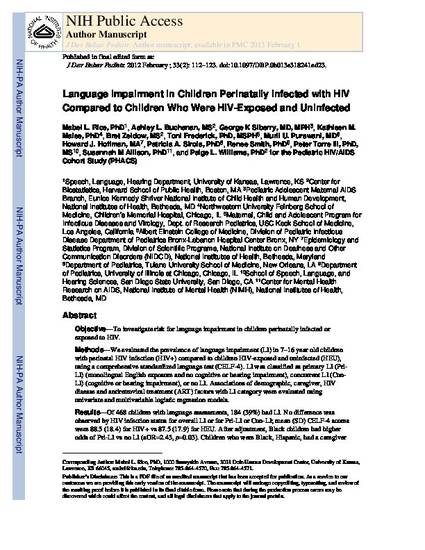
Objective - To investigate risk for language impairment in children perinatally infected or exposed to HIV.
Methods - We evaluated the prevalence of language impairment (LI) in 7–16 year old children with perinatal HIV infection (HIV+) compared to children HIV-exposed and uninfected (HEU), using a comprehensive standardized language test (CELF-4). LI was classified as primary LI (Pri-LI) (monolingual English exposure and no cognitive or hearing impairment), concurrent LI (Con-LI) (cognitive or hearing impairment), or no LI. Associations of demographic, caregiver, HIV disease and antiretroviral treatment (ART) factors with LI category were evaluated using univariate and multivariable logistic regression models.
Results - Of 468 children with language assessments, 184 (39%) had LI. No difference was observed by HIV infection status for overall LI or for Pri-LI or Con-LI; mean (SD) CELF-4 scores were 88.5 (18.4) for HIV+ vs 87.5 (17.9) for HEU. After adjustment, Black children had higher odds of Pri-LI vs no LI (aOR=2.43, p=0.03). Children who were Black, Hispanic, had a caregiver with low education or low IQ, or a non-biological parent as caregiver had higher odds of Con-LI vs no LI. Among HIV+ children, viral load >400 copies/ml (aOR=3.04, pp=0.02) and ART initiation (aOR=2.12, p=0.02) were associated with higher odds of Con-LI vs. no LI.
Conclusions - Children perinatally exposed to HIV are at high risk for LI, but such risk was not increased for youth with HIV. Risk factors differed for Pri-LI and Con-LI.
Rice, M. L., Buchanan, A. L., Siberry, G. K., Malee, K. M., Zeldow, B., Frederick, T.,…Williams, P. L. (2012). Language Impairment in Children Perinatally Infected with HIV Compared to Children Who Were HIV-Exposed and Uninfected. Journal of Developmental & Behavioral Pediatrics, 33(2), 112-123. doi: 10.1097/DBP.0b013e318241ed23
Available at: http://dx.doi.org/10.1097/DBP.0b013e318241ed23
